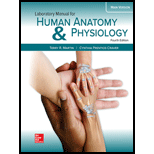
The middle layer of an artery and vein contains mostly
a. connective tissue.
b. simple squamous epithelium.
c. smooth muscle.
d. nervous tissue.
Introduction:
In most animals, the heart is a muscular organ that draws blood of the circulatory system through the blood vessels. In humans, the heart is located in the middle part of the chest, between the lungs. In humans, other mammals and birds, the heart is divided into 4 chambers: the upper left and right atria and the lower left and right ventricle.
Answer to Problem 1PL
Correct answer:
The correct answer is option (c) smooth muscle.
Explanation of Solution
Explanation/justification for the correct answer:
Option (c) smooth muscle. The smooth muscle lacks non-striated muscle. The smooth muscle usually forms the subsidiary tissue of blood vessels and hollow internal organs (stomach, bladder, and intestine). It is seen in the veins and arteries. So, this is the correct option.
Explanation for incorrect answer:
Option (a) connective tissue. Connective tissue is located everywhere, including another body tissue and the nervous system. So, this is an incorrect option.
Option (b) simple squamous epithelium. They are seen in alveoli, glomeruli, capillaries, and other tissues where rapid increase is required. So, this is an incorrect option.
Option (d) nervous tissue. Nervous tissue is seen in Peripheral Nerves everywhere in the body and the Central Nervous System organs, brain, and spinal cord. So, this is an incorrect option.
The middle (or intermediate) layer of an artery and veins includes only smooth muscle. Hence the correct answer is option (c) smooth muscle.
Want to see more full solutions like this?
Chapter 47 Solutions
Laboratory Manual for Human Anatomy & Physiology Main Version
- Which of the following can be included in the description of an artery? A. Remains open when incised B. Solid structure C. Generally some blood present D. Silvery white colorarrow_forwardWhich of the following characteristics is unique to capillaries and not to other blood vessels? A. have low blood pressure B. have high blood pressure C. exchange substances (ions, small molecules and water) between blood and tissues D. carry oxygen and carbon dioxide E. connect to the heart and lungsarrow_forwardProlonged pressure on the skin causes reddened areas at the point of contact due to: Select one: a. Tissue damage and inflammation resulting from impaired capillary blood flow b. Occlusion of major arteries causing infarction of the tissue c. Compression of veins resulting in venous engagement d. Arterial vasodilation from smooth muscle relaxationarrow_forward
- Which of the following statement/s is/are true about veins? A. Inner layer is composed of simple squamous epithelial tissue. B. Middle layer are composed of smooth muscle and elastic connective tissue which contributes to maintenance of diastolic blood pressure. C. Outer layer is composed of fibrous connective tissue to prevent rupture. D. All statements are not true. E. All statements are true. 2. Which of the following statement/s is/are not true about regulation of heart rate? A. The brainstem contains the cardiac centers which are the accelerator center and the inhibitory center. (medulla) B. Sympathetic impulses to the heart increase rate and force of contraction. C. Parasympathetic impulses from cranial nerve X to the heart causes reduction in the heart rate. D. The cranial nerve IX is motor for the carotid receptors. (sensory) 3. Which of the following statement/s is/are true regarding the pericardial membranes? A. The outer layer is made of fibrous connective tissue which is a…arrow_forwardA good example of a superficial vein in the upper extremity is the: A. Brachial B. Axillary C. Median cubital D. Brachial femorisarrow_forwardAs we know that capillaries are single celled layers. Which blood vessel layer is present in capillaries? a. Tunica Media b. Tunica Intima c. Tunica Adventitia d. None of the abovearrow_forward
- Differentiate the three major blood vessels according to: A. TUNICS B. Blood that flows within each blood vessel (color, viscosity, pH, and specific gravity) C. The method of extraction in each blood vesselarrow_forwardMark the following statements as true or false. If a statement is false, correct it to make a true statement a. Arteries are the exchange vessels of the cardiovascular system. b. The tunica intima is composed of a sheet of endothelium, connective tissue, and the internal elastic lamina. c. The tunica media consists of smooth muscle cells innervated by vasomotor nerves. d. Muscular arteries control blood flow at the tissue level. e. Veins have smaller lumens, more elastic fibers, and more smooth muscle than arteries.arrow_forwardMatch the following types of arteries to their descriptions ? provides the greatest resistance to blood flow ? "has more smooth muscle, but less elastin, and delivers blood to specific organs" ? includes the aorta and brachiocephalic arteries A. Muscular Arteries B. Arterioles C. Elastic Arteriesarrow_forward
- Which of the following statements is false?a. Only arteries carry oxygenated blood.b. Both arteries and veins have a layer of smooth muscle.c. Capillary beds lie between arteries and veins.d. Sphincters regulate the flow of blood through capillaries.arrow_forwardConsider a blood clot that formed in a pulmonary venule. If the clot detached, in which of the following vessel types would it be most likely to become stuck? Select one: a. pulmonary vein b. systemic artery c. systemic vein d. pulmonary artery Please don't copy from the internetarrow_forwardThe diameter of veins is typically larger than that of arteries,becausea. veins must carry blood at a higher pressure than arteries.b. veins carry more blood than arteries do.c. veins have fewer muscles to constrain their diameter.d. larger diameter vessels have reduced resistance to flow.arrow_forward

